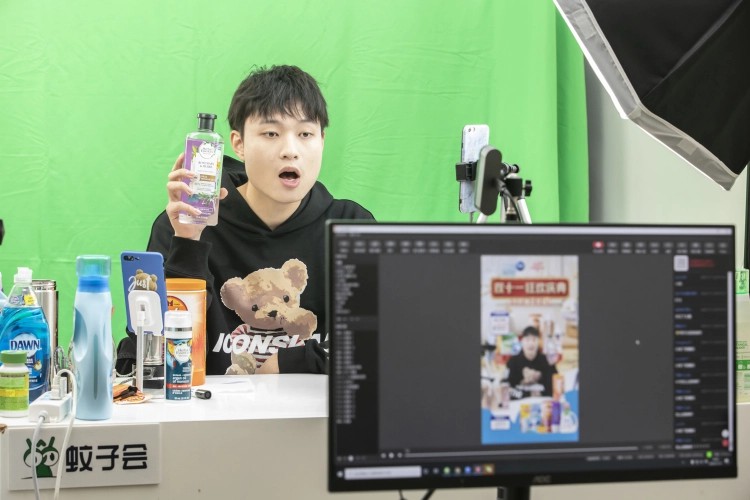 圖片來(lái)源:QILAI SHEN—GETTY IMAGES
圖片來(lái)源:QILAI SHEN—GETTY IMAGES
隨著零售商和品牌逐漸接受通過(guò)直播購(gòu)物來(lái)吸引消費(fèi)者,,這種虛擬形式便成為了2020 年新冠疫情之下的熱門(mén)趨勢(shì)。Qurate Retail集團(tuán)對(duì)這一全球現(xiàn)象有著獨(dú)到的看法,,我們的HSN團(tuán)隊(duì)早在約40年前便在電視上開(kāi)辦視頻直播購(gòu)物節(jié)目,,如今我們的QVC和HSN品牌已經(jīng)成立世界上頗具規(guī)模的視頻商務(wù)平臺(tái),惠及3億8千萬(wàn)家庭,??吹竭@么多公司接納并提升這種強(qiáng)力的零售形式,我們十分高興,。
作為美國(guó)全國(guó)零售聯(lián)合會(huì)(National Retail Federation)的主席,,我親眼目睹了零售行業(yè)在這個(gè)艱難時(shí)刻所表現(xiàn)出來(lái)的非凡韌性和創(chuàng)新精神,零售商們?cè)趲字芑驇讉€(gè)月的時(shí)間內(nèi)就部署了新的購(gòu)物方式,,放在平時(shí)可能需要幾年的時(shí)間,。直播購(gòu)物通過(guò)視頻直播來(lái)分享產(chǎn)品,,回答問(wèn)題并進(jìn)行銷(xiāo)售,用戶(hù)在這個(gè)過(guò)程中能夠遠(yuǎn)程觀看,、聊天和購(gòu)買(mǎi),。這種形式是原本以電視為中心的模式的自然發(fā)展結(jié)果,近些年來(lái)逐漸得到了認(rèn)同,。而現(xiàn)在,,為了應(yīng)對(duì)疫情造成的購(gòu)物限制,世界各地的零售商和品牌都在競(jìng)相將實(shí)時(shí)互動(dòng)視頻的體驗(yàn)加入到營(yíng)銷(xiāo)組合策略中,。
目前的直播購(gòu)物熱潮源自前幾年的中國(guó),,當(dāng)時(shí)一些網(wǎng)絡(luò)紅人通過(guò)視頻直播應(yīng)用程序帶著粉絲一起逛紐約和洛杉磯的精品店,并一路分享和介紹產(chǎn)品,。這些虛擬之旅讓觀眾得以一睹異國(guó)風(fēng)情,,還可以發(fā)掘和購(gòu)買(mǎi)在中國(guó)難以買(mǎi)到的產(chǎn)品。
與此同時(shí),,中國(guó)的電商巨頭開(kāi)始通過(guò)視頻來(lái)推廣直播活動(dòng),,邀請(qǐng)名人直播聊天并無(wú)縫連接購(gòu)物消費(fèi)。2019年雙十一光棍節(jié),,知名網(wǎng)紅薇婭在淘寶進(jìn)行8小時(shí)的直播銷(xiāo)售活動(dòng),,吸引了超過(guò)4300萬(wàn)名顧客。根據(jù)此前的預(yù)計(jì),,2020年直播購(gòu)物會(huì)在中國(guó)產(chǎn)生大約1360億美元收入,。不過(guò),中國(guó)的模式在財(cái)務(wù)上是否可行還是一個(gè)未知數(shù),,畢竟依賴(lài)名人帶貨吸引觀眾的做法花費(fèi)不菲,,而且并不能夠保證提高品牌忠誠(chéng)度或拉攏回頭客。
美國(guó)和歐洲則出現(xiàn)了多種多樣的模式,。和中國(guó)一樣,,把商務(wù)視頻投放到知名電商或社交應(yīng)用程序仍然是引流的領(lǐng)先做法。Instagram已經(jīng)在其應(yīng)用程序中添加了購(gòu)物功能,,Instagram Live也是如此。Facebook正在開(kāi)發(fā)原生直播購(gòu)物工具,,有媒體標(biāo)題直言《Facebook Live是新QVC》,。另外,沃爾瑪(Walmart)最近開(kāi)始與TikTok合作,,在直播中推銷(xiāo)產(chǎn)品,。亞馬遜(Amazon)也推出了Amazon Live,觀眾可以在節(jié)目中購(gòu)物,,品牌也能夠利用其配套工具進(jìn)行編程,。
其他公司正在開(kāi)發(fā)線(xiàn)上市場(chǎng)發(fā)展直播購(gòu)物,,或者幫助零售商和品牌利用直播吸引觀眾數(shù)字化參與。一些公司也在嘗試更加個(gè)性化的直播,,為顧客和在店內(nèi)購(gòu)物的人或員工建立聯(lián)系,,或者允許用戶(hù)直接互相銷(xiāo)售。
這些圍繞直播購(gòu)物的活動(dòng)熱潮反映了幾大趨勢(shì),。新技術(shù)的出現(xiàn)讓人們更方便制作和分享視頻體驗(yàn),,數(shù)字媒體消費(fèi)得以爆炸性增長(zhǎng)。名人與社交紅人對(duì)購(gòu)物決策的影響也越來(lái)越大,。新冠疫情促使數(shù)百萬(wàn)消費(fèi)者在線(xiàn)上與零售商和品牌互動(dòng),,許多人在疫情之后的很長(zhǎng)一段時(shí)間內(nèi)也會(huì)繼續(xù)這么做。
直播購(gòu)物在鋪天蓋地之際也會(huì)繼續(xù)發(fā)展演化,,帶來(lái)無(wú)限可能,。社交媒體上的人工智能或許可以讓我們?yōu)槊课豢蛻?hù)提供完全個(gè)性化的直播渠道和互動(dòng)內(nèi)容,專(zhuān)為他們量身定制和精選,。又或者,,虛擬現(xiàn)實(shí)技術(shù)能夠讓我們把顧客帶到時(shí)裝秀直播現(xiàn)場(chǎng)的前排座位,旁邊就坐著一位親切的主持人,,已經(jīng)準(zhǔn)備好回答問(wèn)題和接受訂單,。
短期內(nèi),這個(gè)行業(yè)的新來(lái)人士需要克服一些更實(shí)際的挑戰(zhàn),,比如直播購(gòu)物的線(xiàn)上引流成本正在迅速上升,。無(wú)論是支付名人巨額費(fèi)用,還是大舉投資付費(fèi)媒體,,這些營(yíng)銷(xiāo)成本可能會(huì)很快吞噬預(yù)算,。他們必須時(shí)刻關(guān)注經(jīng)濟(jì)。如果開(kāi)價(jià)不夠有競(jìng)爭(zhēng)力,,或者無(wú)法有效服務(wù)客戶(hù)和分銷(xiāo)產(chǎn)品,,成功會(huì)轉(zhuǎn)瞬即逝。
投身直播領(lǐng)域的公司也應(yīng)該了解到,,視頻購(gòu)物并不僅僅關(guān)于最新技術(shù)或者網(wǎng)絡(luò)紅人,。太多新入局者只關(guān)注表面而不重視實(shí)質(zhì)。那些堅(jiān)持下來(lái)的人會(huì)明白,,正如以前那些生意興隆的百貨商場(chǎng)所做的那樣,,成功的關(guān)鍵在于建立持久的客戶(hù)關(guān)系。零售的基本需求從未改變,,即便是在虛擬世界中,,它依然關(guān)乎人際關(guān)系的力量和發(fā)現(xiàn)的樂(lè)趣。在喜歡的商店中閑逛,進(jìn)行有趣的對(duì)話(huà),,了解產(chǎn)品背后的故事,,并從中獲得啟發(fā)。
看到這種有著40年歷史的商業(yè)模式重?zé)ㄇ啻?,其?shí)十分有趣,。根據(jù)最近的發(fā)展趨勢(shì),只要我們不讓技術(shù)脫離人性,,它就有可能給當(dāng)今的居家消費(fèi)者帶來(lái)最好的實(shí)體購(gòu)物體驗(yàn),。(財(cái)富中文網(wǎng))
麥克?喬治是Qurate Retail集團(tuán)的主席兼首席執(zhí)行官,該集團(tuán)旗下有QVC,、HSN,、Zulily和Cornerstone這些品牌。此外,,他也是美國(guó)全國(guó)零售聯(lián)合會(huì)的主席,。
譯者:秦維奇
隨著零售商和品牌逐漸接受通過(guò)直播購(gòu)物來(lái)吸引消費(fèi)者,這種虛擬形式便成為了2020 年新冠疫情之下的熱門(mén)趨勢(shì),。Qurate Retail集團(tuán)對(duì)這一全球現(xiàn)象有著獨(dú)到的看法,,我們的HSN團(tuán)隊(duì)早在約40年前便在電視上開(kāi)辦視頻直播購(gòu)物節(jié)目,如今我們的QVC和HSN品牌已經(jīng)成立世界上頗具規(guī)模的視頻商務(wù)平臺(tái),,惠及3億8千萬(wàn)家庭,。看到這么多公司接納并提升這種強(qiáng)力的零售形式,,我們十分高興,。
作為美國(guó)全國(guó)零售聯(lián)合會(huì)(National Retail Federation)的主席,我親眼目睹了零售行業(yè)在這個(gè)艱難時(shí)刻所表現(xiàn)出來(lái)的非凡韌性和創(chuàng)新精神,,零售商們?cè)趲字芑驇讉€(gè)月的時(shí)間內(nèi)就部署了新的購(gòu)物方式,,放在平時(shí)可能需要幾年的時(shí)間。直播購(gòu)物通過(guò)視頻直播來(lái)分享產(chǎn)品,,回答問(wèn)題并進(jìn)行銷(xiāo)售,,用戶(hù)在這個(gè)過(guò)程中能夠遠(yuǎn)程觀看、聊天和購(gòu)買(mǎi),。這種形式是原本以電視為中心的模式的自然發(fā)展結(jié)果,,近些年來(lái)逐漸得到了認(rèn)同。而現(xiàn)在,,為了應(yīng)對(duì)疫情造成的購(gòu)物限制,,世界各地的零售商和品牌都在競(jìng)相將實(shí)時(shí)互動(dòng)視頻的體驗(yàn)加入到營(yíng)銷(xiāo)組合策略中。
目前的直播購(gòu)物熱潮源自前幾年的中國(guó),,當(dāng)時(shí)一些網(wǎng)絡(luò)紅人通過(guò)視頻直播應(yīng)用程序帶著粉絲一起逛紐約和洛杉磯的精品店,,并一路分享和介紹產(chǎn)品。這些虛擬之旅讓觀眾得以一睹異國(guó)風(fēng)情,,還可以發(fā)掘和購(gòu)買(mǎi)在中國(guó)難以買(mǎi)到的產(chǎn)品,。
與此同時(shí),中國(guó)的電商巨頭開(kāi)始通過(guò)視頻來(lái)推廣直播活動(dòng),,邀請(qǐng)名人直播聊天并無(wú)縫連接購(gòu)物消費(fèi),。2019年雙十一光棍節(jié),知名網(wǎng)紅薇婭在淘寶進(jìn)行8小時(shí)的直播銷(xiāo)售活動(dòng),,吸引了超過(guò)4300萬(wàn)名顧客,。根據(jù)此前的預(yù)計(jì),2020年直播購(gòu)物會(huì)在中國(guó)產(chǎn)生大約1360億美元收入,。不過(guò),,中國(guó)的模式在財(cái)務(wù)上是否可行還是一個(gè)未知數(shù),畢竟依賴(lài)名人帶貨吸引觀眾的做法花費(fèi)不菲,,而且并不能夠保證提高品牌忠誠(chéng)度或拉攏回頭客,。
美國(guó)和歐洲則出現(xiàn)了多種多樣的模式。和中國(guó)一樣,,把商務(wù)視頻投放到知名電商或社交應(yīng)用程序仍然是引流的領(lǐng)先做法,。Instagram已經(jīng)在其應(yīng)用程序中添加了購(gòu)物功能,Instagram Live也是如此,。Facebook正在開(kāi)發(fā)原生直播購(gòu)物工具,,有媒體標(biāo)題直言《Facebook Live是新QVC》。另外,,沃爾瑪(Walmart)最近開(kāi)始與TikTok合作,,在直播中推銷(xiāo)產(chǎn)品。亞馬遜(Amazon)也推出了Amazon Live,,觀眾可以在節(jié)目中購(gòu)物,,品牌也能夠利用其配套工具進(jìn)行編程。
其他公司正在開(kāi)發(fā)線(xiàn)上市場(chǎng)發(fā)展直播購(gòu)物,,或者幫助零售商和品牌利用直播吸引觀眾數(shù)字化參與,。一些公司也在嘗試更加個(gè)性化的直播,為顧客和在店內(nèi)購(gòu)物的人或員工建立聯(lián)系,,或者允許用戶(hù)直接互相銷(xiāo)售,。
這些圍繞直播購(gòu)物的活動(dòng)熱潮反映了幾大趨勢(shì)。新技術(shù)的出現(xiàn)讓人們更方便制作和分享視頻體驗(yàn),,數(shù)字媒體消費(fèi)得以爆炸性增長(zhǎng),。名人與社交紅人對(duì)購(gòu)物決策的影響也越來(lái)越大。新冠疫情促使數(shù)百萬(wàn)消費(fèi)者在線(xiàn)上與零售商和品牌互動(dòng),,許多人在疫情之后的很長(zhǎng)一段時(shí)間內(nèi)也會(huì)繼續(xù)這么做,。
直播購(gòu)物在鋪天蓋地之際也會(huì)繼續(xù)發(fā)展演化,帶來(lái)無(wú)限可能。社交媒體上的人工智能或許可以讓我們?yōu)槊课豢蛻?hù)提供完全個(gè)性化的直播渠道和互動(dòng)內(nèi)容,,專(zhuān)為他們量身定制和精選,。又或者,虛擬現(xiàn)實(shí)技術(shù)能夠讓我們把顧客帶到時(shí)裝秀直播現(xiàn)場(chǎng)的前排座位,,旁邊就坐著一位親切的主持人,,已經(jīng)準(zhǔn)備好回答問(wèn)題和接受訂單。
短期內(nèi),,這個(gè)行業(yè)的新來(lái)人士需要克服一些更實(shí)際的挑戰(zhàn),,比如直播購(gòu)物的線(xiàn)上引流成本正在迅速上升。無(wú)論是支付名人巨額費(fèi)用,,還是大舉投資付費(fèi)媒體,,這些營(yíng)銷(xiāo)成本可能會(huì)很快吞噬預(yù)算。他們必須時(shí)刻關(guān)注經(jīng)濟(jì),。如果開(kāi)價(jià)不夠有競(jìng)爭(zhēng)力,,或者無(wú)法有效服務(wù)客戶(hù)和分銷(xiāo)產(chǎn)品,成功會(huì)轉(zhuǎn)瞬即逝,。
投身直播領(lǐng)域的公司也應(yīng)該了解到,,視頻購(gòu)物并不僅僅關(guān)于最新技術(shù)或者網(wǎng)絡(luò)紅人。太多新入局者只關(guān)注表面而不重視實(shí)質(zhì),。那些堅(jiān)持下來(lái)的人會(huì)明白,,正如以前那些生意興隆的百貨商場(chǎng)所做的那樣,成功的關(guān)鍵在于建立持久的客戶(hù)關(guān)系,。零售的基本需求從未改變,,即便是在虛擬世界中,它依然關(guān)乎人際關(guān)系的力量和發(fā)現(xiàn)的樂(lè)趣,。在喜歡的商店中閑逛,,進(jìn)行有趣的對(duì)話(huà),了解產(chǎn)品背后的故事,,并從中獲得啟發(fā),。
看到這種有著40年歷史的商業(yè)模式重?zé)ㄇ啻海鋵?shí)十分有趣,。根據(jù)最近的發(fā)展趨勢(shì),,只要我們不讓技術(shù)脫離人性,它就有可能給當(dāng)今的居家消費(fèi)者帶來(lái)最好的實(shí)體購(gòu)物體驗(yàn),。(財(cái)富中文網(wǎng))
麥克?喬治是Qurate Retail集團(tuán)的主席兼首席執(zhí)行官,,該集團(tuán)旗下有QVC、HSN,、Zulily和Cornerstone這些品牌,。此外,,他也是美國(guó)全國(guó)零售聯(lián)合會(huì)的主席。
譯者:秦維奇
Livestream shopping is one of the hottest trends to emerge from a pandemic-scarred 2020, as retailers and brands embrace this virtual approach to engaging consumers. At Qurate Retail, we have a unique vantage point to observe this global phenomenon, as our HSN team invented live video shopping on TV about 40 years ago, and today our QVC and HSN brands form one of the world’s largest video commerce platforms, reaching 380 million homes. We’re excited to see so many companies embrace and elevate this powerful form of retailing.
As chair of the National Retail Federation (NRF), I’ve observed firsthand the remarkable resilience and innovative spirit of our industry in this difficult hour, with retailers deploying new shopping approaches in weeks or months that might have taken years in ordinary times. Livestream shopping—using live video to share products, answer questions, and close sales with customers who are joining remotely to watch, chat, and buy—is a natural outgrowth of the original TV-centered model and has been gradually gaining traction in recent years. But now, responding to shopping restrictions imposed by the pandemic, retailers and brands worldwide are racing to add live, interactive video experiences into their marketing mix.
The current livestream shopping craze has its roots in China in the mid-2010s, when influencers began using live video apps to take their fans with them as they traveled to boutiques in New York or Los Angeles, sharing and explaining products along the way. These virtual journeys offered viewers a glimpse of exotic locations with the option to discover and buy products that were not readily available in China.
China’s e-commerce giants, meanwhile, began offering live events via video, hosted by celebrities, with live chat and seamless purchasing. Chinese consumers loved it. On Singles Day 2019, Taobao’s sales event featured an eight-hour livestream with popular influencer Viya that attracted more than 43 million customers. In 2020, livestream shopping was projected to generate about $136 billion in revenue in China. Nonetheless, the financial viability of China’s approach remains a question mark, in part because of its reliance on celebrities to attract audiences, a costly approach that doesn’t always translate into brand loyalty and repeat purchasing.
In the U.S. and Europe, a variety of approaches are emerging. As in China, the leading model involves adding video commerce to popular e-commerce or social apps to tap their audiences and influencers. Instagram has added shopping capabilities throughout its apps, including Instagram Live. Facebook is developing native livestream shopping tools, with one headline announcing that “Facebook Live is the new QVC.” Walmart recently began partnering with TikTok to offer its products via livestream. Amazon launched Amazon Live, with an array of shoppable shows and a suite of tools that enable brands to create their own programming.
Other players are developing online marketplaces for livestream shopping or are helping retailers and brands use livestreams to engage audiences on their digital properties. Some are experimenting with more personalized livestreams that connect customers to shoppers or staff in-store or allow users to sell directly to each other.
This whirlwind of activity around livestream shopping reflects several megatrends. Digital media consumption is exploding, as new technologies make it easier than ever to create and share video-based experiences. Celebrities and social influencers are having a growing impact on purchase decisions. COVID-19 has pushed millions of consumers to increasingly interact with retailers and brands online, and many will likely continue to do so long after the pandemic is over.
As livestream shopping expands, it will continue to evolve, and the possibilities are dazzling. Perhaps artificial intelligence on social media will enable us to provide each customer with a fully individualized channel of live, interactive content, curated just for them. Maybe virtual reality will allow us to transport the customer to a front-row seat at a livestream fashion show, right next to a friendly host who is ready to answer questions and take an order.
In the near term, new entrants need to conquer more practical challenges, such as the rapidly rising cost of attracting online traffic to live shopping. Whether paying a high-profile celebrity or investing heavily in paid media, these marketing costs can quickly chew up budgets. New players must also keep an eye on economics. Those who fail to offer competitive prices, as well as to efficiently service customers and distribute products, will find success short-lived.
Companies jumping into livestreaming also need to learn that video shopping is about more than the latest technology or the influencer of the moment. Too many new players seem intent on flash over substance. Those who endure will understand that the key to success, as it was for the great emporiums of old, is building lasting relationships, customer by customer. The basic needs that have always defined retail haven’t changed. Even in the virtual world, it’s still about the power of human connection and the joy of discovery—wandering into your favorite shop, having interesting conversations, learning the stories behind the products, and getting inspired.
It’s fun to see this 40-year-old business model suddenly young again. The latest developments offer the potential to bring the best of physical shopping to today’s stay-at-home consumer, as long as we bring our humanity along with the technology.
Mike George is president and CEO of Qurate Retail, Inc., comprising QVC, HSN, Zulily, and the Cornerstone Brands. He is also chairman of the National Retail Federation.






